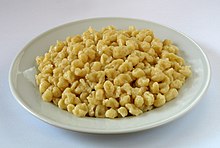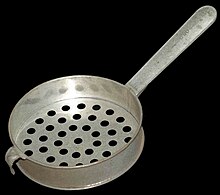Spätzle


Spätzle [ˈʃpɛtslə] (Swabian diminutive of Spatz, thus literally "little sparrow", also Spätzli or Chnöpfli in Switzerland or Knöpfle or Hungarian nokedli or galuska) are a type of egg noodle of soft texture found in the cuisine of Germany and of Austria, Switzerland, Hungary, Alsace and South Tyrol.
History
The geographic origin of spätzle is not precisely known; various regions claim to be the originators of this noodle. Written mention of Spätzle has been found in documents dating from 1725, although medieval illustrations are believed to place this noodle at an even earlier date.[1] Noodles more generally have a history extending back 4,000 years (see Noodle and Pasta).
Today, in Europe spätzle are largely considered a "Swabian speciality"[2] and are generally associated with the German states of Baden-Württemberg and Bavaria. The total estimated annual commercial production of spätzle in Germany is approximately 40,000 tons[3]. The leading German producer, Herrmann, which once produced 13,000 tons per year,[4] ceased production as of 24 March 2012 , following a 50% reduction in demand[5]. Pre-made spätzle are also available internationally from companies such as Maggi, a division of Nestlé.[6]
Etymology
The linguistic origin[7] of Spätzle is debated. Literally translated, Spätzle means "little sparrow".
Before the invention and use of mechanical devices to make these noodles, they were shaped by hand or with a spoon and the results resembled Spatzen (meaning little sparrows, sparrow is Haus-Spatz or Sperling in German).
Knöpfle means "small buttons" and describes the compact form of this spätzle variety.
Preparation




Spätzle dough typically consists of few ingredients, principally eggs, flour, and salt. Often, water is added to produce a thinner dough.[8]
Traditionally, Spätzle are made by scraping dough off a wooden chopping board ("Spätzlebrett") into boiling salt water where they cook until they rise to the surface. They are then skimmed and put aside.
Since this can be a cumbersome way to prepare spätzle, several devices were invented to facilitate cooking that resemble a strainer, (or colander), a potato ricer ("Spätzlepresse"), a food mill or coarse grater ("Spätzlehobel"). As with scraped Spätzle, the dough drops into the boiling water.
Dough varieties
For certain specialty dishes, the dough may be enriched with minced pork liver (resulting in Leberspätzle), spinach, or finely grated cheese.
Commercial products
Commercially made noodles marketed as spätzle may bear little resemblance to handmade spätzle, being more or less regular in shape and more solid in mouthfeel. Most popular are dried spätzle that are cooked in boiling water like ordinary egg noodles. But as of late,[when?] pre-cooked Spätzle has become available as well in supermarket refrigerators.
Dishes



Spätzle typically accompany meat dishes prepared with an abundant sauce or gravy, such as Zwiebelrostbraten, Sauerbraten or Rouladen. In Hungary spätzle often are used in soup. Spätzle also are used as a primary ingredient in dishes including:
- Savory
- Linsen, Spätzle und Saitenwürstle: Spätzle with lentils and fine-skinned, frankfurter-style sausages
- Käsespätzle: Spätzle mixed with grated cheese (typically Emmenthaler) and fried onion
- Gaisburger Marsch: Traditional Swabian beef stew
- Krautspätzle: Spätzle mixed with sauerkraut, onion, butter and spices such as marjoram and/or caraway
- Leberspätzle
- Spinatspatzeln (Tyrolean dialect): Spätzle which also contain spinach as one of the ingredients; a speciality of Trentino-Alto Adige/Südtirol
- Sweet
- Kirschspätzle: Spätzle mixed with fresh cherries, dressed with clarified, browned butter, sugar and cinnamon and/or nutmeg. In Allgäu, this is served as a one-dish supper in late summer.
- Apfelspätzle: Spätzle with grated apples in the dough, dressed with clarified, browned butter, sugar, and cinnamon. In Allgäu, this is served as a one-dish supper in autumn.
See also
- Schupfnudel
- Klöße, larger dumplings
- Halušky, eastern European equivalent of spätzle
- Gnocchi, similar Italian dumplings/noodles
- Passatelli, similar Italian noodles made with bread crumbs in place of flour
References
- ^ German Embassy London - Spätzle
- ^ Spezialitäten aus Baden-Württemberg (German)
- ^ World on a plate
- ^ Spaetzle.de - Allerei rund um Spätzle - Wissenswertes (German)
- ^ - Das Ende einer Aera
- ^ Maggi USA - European
- ^ Food from Bavaria - Typical Regional Specialty (Käsespätzle)
- ^ Basic-Recipes.com - Spätzle
